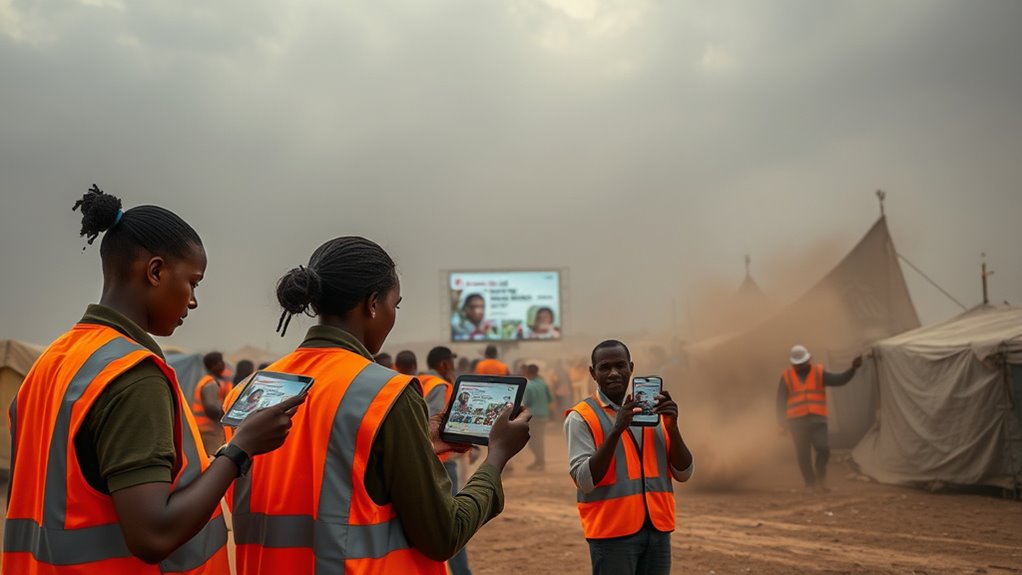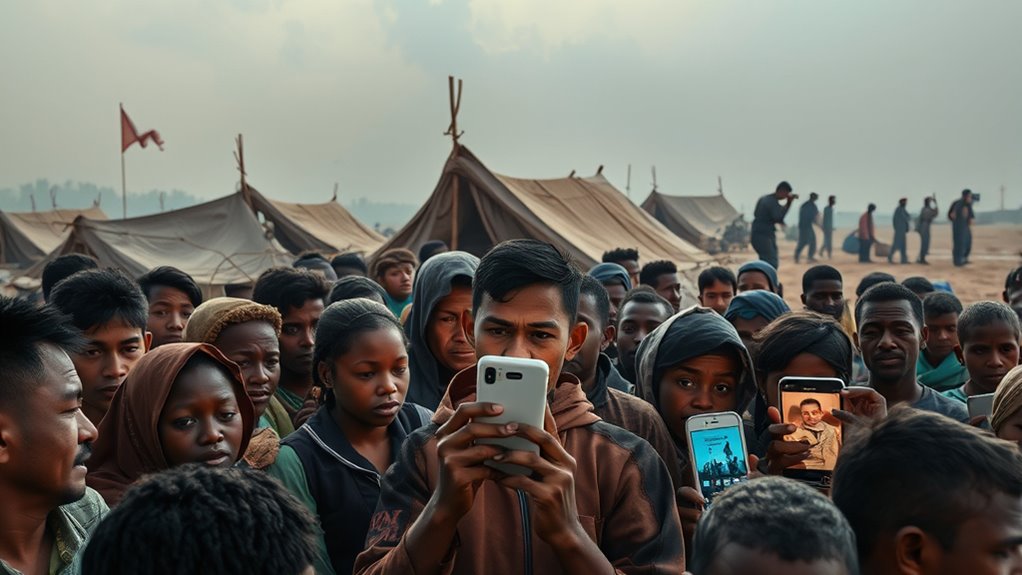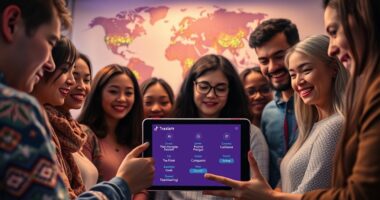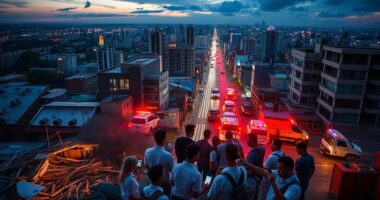Social media plays a essential role during humanitarian crises by enabling quick communication, real-time updates, and resource mobilization. It helps you connect affected communities, aid organizations, and governments efficiently, ensuring relief efforts are coordinated and effective. While sharing essential information, it’s imperative to protect privacy and verify facts to prevent misinformation. Proper use of platform tools and digital literacy empowers you to participate safely and responsibly. Discover more about how social media enhances crisis response as you explore further.
Key Takeaways
- Social media enables rapid communication, real-time updates, and coordination among affected communities, aid organizations, and authorities during crises.
- It facilitates quick sharing of critical information, helping mobilize resources and foster community resilience in emergencies.
- Platform tools like verified accounts and reporting mechanisms enhance the dissemination of accurate information and reduce misinformation spread.
- Ensuring data privacy and security maintains community trust and protects sensitive information from misuse.
- Promoting digital literacy and responsible platform use helps verify information, prevent panic, and optimize social media’s role in humanitarian response.

In recent years, social media has become a pivotal tool in humanitarian crises, enabling rapid communication and coordination among affected communities, aid organizations, and governments. When disaster strikes or emergencies unfold, these platforms allow you to share real-time updates, request help, and organize relief efforts swiftly. However, with this power comes responsibility. You need to be mindful of data privacy; sensitive information shared on social media can be exploited if not properly protected. Aid organizations and users must guarantee personal data is secured, avoiding the risk of identity theft or misuse. Implementing robust privacy measures helps maintain trust among communities, ensuring they feel safe sharing essential information without fear of exploitation. Additionally, understanding the importance of projector contrast ratio can be metaphorically applied to ensure the clarity and visibility of critical information in digital communications, emphasizing the need for high contrast in visual media for effective messaging.
Protect sensitive data on social media to ensure trust and safety during humanitarian crises.
Misinformation control is another key aspect. During crises, false information can spread rapidly, causing confusion, panic, or even hindering relief efforts. As someone actively involved in social media communication, you play an indispensable role in verifying facts before sharing. Relying on credible sources and official updates helps prevent the proliferation of rumors that can derail response efforts. Many organizations now employ fact-checkers and content moderation tools to flag or remove misleading posts. You should also be cautious of sensationalized messages that may exaggerate or distort reality, as these can undermine public confidence and complicate coordination. Promoting transparency and accuracy strengthens the overall response and helps affected populations make informed decisions.
Furthermore, social media platforms are increasingly integrating tools to combat misinformation and enhance data privacy. Features like verified accounts, reporting mechanisms, and privacy settings give you more control over the information you share and consume. Aid organizations often use these tools to disseminate verified updates, reducing the chance of misinformation spreading unchecked. As a user, staying vigilant about the sources of information and understanding privacy settings can profoundly impact the effectiveness of humanitarian communication. Educating communities on digital literacy helps them discern reliable information from falsehoods, empowering them to participate actively and safely in relief efforts.
In essence, social media’s role in humanitarian crises hinges on balancing rapid information sharing with responsible management of data privacy and misinformation. When used correctly, these platforms can mobilize resources, coordinate aid, and foster community resilience. But it’s up to you to stay informed, protect sensitive data, and verify the information you encounter. This guarantees that social media remains a powerful tool for positive impact, supporting effective, trustworthy, and safe humanitarian responses in times of need.
Frequently Asked Questions
How Do Social Media Algorithms Influence Crisis Information Dissemination?
Social media algorithms shape crisis information dissemination by prioritizing content with high engagement metrics, which can amplify urgent messages but also spread misinformation. Algorithm bias may favor sensational stories over accurate updates, affecting your perception of the crisis. You might notice that posts with more likes and shares reach wider audiences, influencing how quickly and broadly crucial information spreads during emergencies.
What Are the Privacy Concerns for Vulnerable Populations Using Social Media?
Imagine walking a tightrope where your every move is scrutinized—that’s how vulnerable populations face privacy concerns on social media. You risk exposing sensitive data privacy and encountering consent challenges that threaten your safety. Social media platforms often lack robust protections, making it difficult to control who sees your information. In crises, this exposes you to risks like discrimination or harm, emphasizing the urgent need for stronger privacy safeguards and clear consent processes.
How Can Misinformation Spread Be Effectively Countered During Crises?
You can effectively counter misinformation during crises by supporting fact-checking initiatives and promoting community engagement. Encourage people to verify information before sharing it and leverage trusted local voices to spread accurate updates. By fostering open dialogue and empowering communities to question false claims, you help diminish the spread of misinformation. Active collaboration with fact-checkers and community leaders ensures that accurate information reaches vulnerable populations quickly and reliably.
What Role Do Social Media Influencers Play in Humanitarian Efforts?
You see, social media influencers play a crucial role in humanitarian efforts by leveraging their credibility to raise awareness and mobilize support. When they form campaign partnerships, they can reach large audiences quickly and inspire action. Their authentic voice helps foster trust, making their messages more impactful. As an influencer, your credibility can directly influence public engagement, encouraging donations, volunteering, or spreading critical information during crises.
How Is Social Media Used to Coordinate Long-Term Recovery Initiatives?
You can use social media to effectively coordinate long-term recovery initiatives by fostering community engagement and resource mobilization. By sharing updates, success stories, and needs openly, you encourage collaboration among stakeholders. You also activate resources quickly, connecting volunteers, donors, and organizations directly. This real-time communication accelerates recovery efforts, ensures transparency, and keeps everyone informed and involved, ultimately making the recovery process more efficient and inclusive.
Conclusion
In summary, social media proves to be a powerful tool in humanitarian crises, enabling real-time information sharing and rapid mobilization. It’s a double-edged sword—you need to stay vigilant about misinformation while harnessing its potential for good. Remember, the early bird catches the worm, so acting quickly on social media can make all the difference. By leveraging these platforms wisely, you can help save lives and bring hope where it’s needed most.










